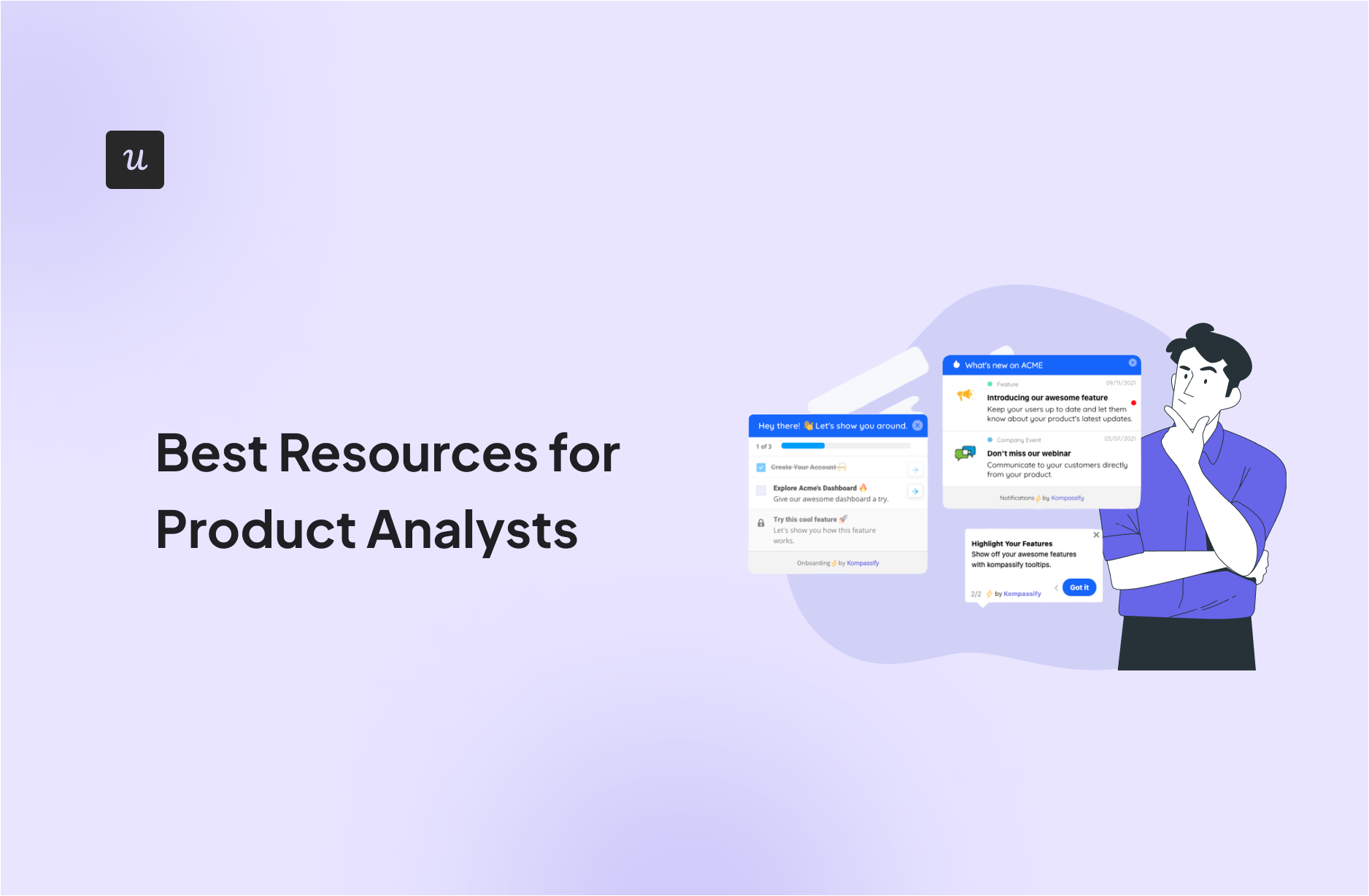
Try Userpilot Now
See Why 1,000+ Teams Choose Userpilot

Resources for product analysts – summary
- A product analyst is a professional who conducts product research, analyzes, and interprets such data to make accurate decisions about the product. Product analysis involves two major things: the product and the data.
- There are insightful resources on the internet on product analysis, ranging from books to webinars to podcasts to blogs. Here is a compilation of the best resources for product analysis:
- Books: Gain foundational knowledge with “Product Analytics” and “Lean Analytics” to learn how to extract customer insights and leverage data for business growth. “Now You See It” equips you with data visualization skills for effective analysis and presentation.
- Webinars: Enhance your expertise with Userpilot’s webinars on user research, product metrics, and data-driven decision-making. Explore broader data analysis topics with Product Alliance, DataCamp, and Tableau.
- Blogs & Podcasts: Stay updated with industry insights from Userpilot, Product Talk, and the IBM Big Data & Analytics Blog. Learn practical data storytelling and scaling techniques with podcasts like RAMP by InsightSquared, Data Stories, and The Product Podcast.
- Unveiling valuable insights from your data is key to product success. Here’s a look at some top-rated tools to empower your product analysis:
- Best tool for Product Analysis (Userpilot): Userpilot gives you insight into your product performance and helps you understand user behavior.
- Best tool for Product Insights (Mixpanel): Mixpanel helps you understand your customer experience and find out what works and what does not.
- Best tool for Business Intelligence (Tableau): Tableau is a business intelligence tool that helps you transform your data into insights you can easily present to stakeholders.
- Best tool for Data streamlining and presentation (Power BI): With Power BI, you can connect data from different sources and analyze and visualize them for easy data reporting.
- Best tool for Data Visualization (Google Charts): Google Charts provides a variety of chart and graph types for top-notch data visualization, making your presentation detailed and insightful.
- Looking into tools for product analysts? Userpilot is an all-in-one product platform with engagement features and powerful analytics capabilities. Book a demo to see it in action!
What is a product analyst?
A product analyst is a professional who conducts product research, analyzes, and interprets such data to make accurate decisions about the product. Product analysis involves two major things: the product and the data.
The product analyst is a crucial role in a company because it helps you gain an understanding of your product and the user, which is important to drive enough sales and grow as a company.
What does a product analyst do?
When it comes to working on a product, the assumption is like shooting arrows into the dark, it will lead to a waste of effort and resources, hence the need for clear insights. That’s where a product analyst comes in. The product analyst provides clear and actionable insights to stakeholders about the product and enables them to make data-driven product decisions.
Here is a breakdown of what a product analyst does:
- Market research for trends identification: A product analyst conducts market research, gathers historical data, and identifies the trends and patterns that are pivotal in making the right product decisions.
- Collection of customer feedback: A product analyst gathers customer feedback via in-depth one-on-one interviews, surveys for a focus group, or even opinion polls.
- Data analysis: Once all the data has been collected, the product analyst analyzes the data, interprets it, and makes product recommendations to stakeholders.
- Presentation of report findings to stakeholders: Based on the data obtained from the research and analysis, the product analyst presents their report to company stakeholders.
- Monitoring of Product Performance: After the product launch, the product analyst monitors the product performance and keeps track of product feedback from customers and industry/market trends, which enables the company to make necessary changes when needed.
It is important to note that a product analyst is needed in every phase of the product lifecycle and is always relevant in the company.
Product analyst’s main responsibilities
The responsibility of a product analyst can be summed up as providing insights that drive accurate and data-driven decisions. Without the product analyst, stakeholders are left to make important decisions based on guesswork.
Here is a detailed breakdown responsibilities and duties of a product analyst:
- Carrying out adequate customer research and gathering data about the use to analyze customer behavior.
- Carrying out extensive market research to identify patterns and trends that serve as pointers for product strategies.
- Making inferences from data obtained and reporting it to stakeholders simply and visually.
- Monitoring the product market performance and proposing necessary changes.
- Assist in developing the product roadmap, aligning it with company goals, market trends, and customer requirements.
- Collaborate with cross-functional teams, including engineering, marketing, sales, and customer support, to ensure successful product delivery and adoption.
- Monitor competitor products and strategies, identifying strengths, weaknesses, and opportunities for differentiation.
- Establish and maintain a structured feedback loop with customers, internal stakeholders, and other relevant parties to gather insights for continuous product improvement.
Best resources for product analysts
There are insightful resources on the internet on product analysis, ranging from books to webinars to podcasts to blogs. Here is a compilation of the best resources for product analysis:
Best books for product analysts
- Product Analytics: Applied Data Science Techniques for Actionable Consumer Insights by Joanne Rodrigues-Craig: In the book, Joanne explained in detail how to gain customer insights through data. It’s a book anyone looking to get into product analysis should read.
- Lean Analytics: Use Data to Build a Better Startup Faster by Alistair Croll & Benjamin Yoskovitz: The book explains how to leverage data to build your business and contains over 30 case studies based on real-world scenarios and interviews with founders and investors.
- Now You See It: An Introduction to Visual Data Sensemaking by Stephen Few: The book explains data visualization extensively, including how to analyze and interpret data and also present them to stakeholders.
Best webinars for product analysts
Here’s a curated list of top webinar sources packed with valuable content for product analysts, covering various areas of expertise:
- Userpilot hosts webinars on product management topics where data analysis plays a crucial role. Look for webinars on user research, product metrics, and data-driven decision-making.
- Product Alliance is a product management community that occasionally hosts webinars on using data to inform product decisions. These webinars can help product analysts understand how their work impacts the product roadmap.
- DataCamp offers free and paid webinars on various data analysis topics, including SQL queries, data manipulation in Python or R, and data visualization best practices.
- Tableau frequently hosts webinars on data visualization using their popular software. You can also find webinars on broader data analysis topics.
Best blogs for product analysts
- Userpilot: The userpilot blog covers different topics on product analysis in-depth.
- Product Talk: Product Talk is a blog resource for every individual in the product, including product analysts, product managers, and product marketers.
- IBM Big Data and Analytics Blog: The IBM Big Data and Analytics Blog is where you get to read from thought leaders in the data analytics world.
Best podcasts for product analysts
- RAMP By InsightSquared: The podcast by InsightSquared provides insight on how to scale your SaaS using analytics.
- Best Podcast for Data Visualization: Data Stories: The podcast focuses on data visualization and features real-world scenarios.
- The Product Podcast: The product podcast speaks to product professionals and covers topics ranging from interviews with top product individuals to career advice for people looking to get into the product world.
Best tools for product analysts
- Best tool for Product Analysis (Userpilot): Userpilot gives you insight into your product performance and helps you understand user behavior.
- Best tool for Product Insights (Mixpanel): Mixpanel helps you understand your customer experience and find out what works and what does not.
- Best tool for Business Intelligence (Tableau): Tableau is a business intelligence tool that helps you transform your data into insights you can easily present to stakeholders.
- Best tool for Data streamlining and presentation (Power BI): With Power BI, you can connect data from different sources and analyze and visualize them for easy data reporting.
- Best tool for Data Visualization (Google Charts): Google Charts provides a variety of chart and graph types for top-notch data visualization, making your presentation detailed and insightful.
Conclusion
Professional growth is a continuous journey, and investing in your development is key to staying competitive in the field.
We hope this guide has equipped you with the tools and knowledge needed to excel in your role.
Looking into tools for product analysts? Userpilot is an all-in-one product platform with engagement features and powerful analytics capabilities. Book a demo to see it in action!







